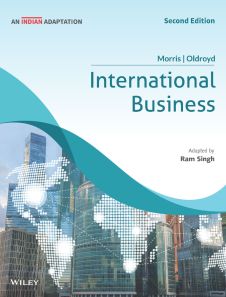International Business, 2ed (An Indian Adaptation)
ISBN: 9789354249334
For more information write to us at: acadmktg@wiley.com

Description
This book on International Business focuses on issues of globalization demonstrating how it has helped nations and societies to transform their political and economic systems as well as how nations can further reorient their systems to specific national, industrial, and societal needs. It further demonstrates how companies can enter international markets, manage the marketing, financial, HR, and supply-chain operations of a business enterprise in diverse global markets, and expand and diversify in vast global markets with right business strategies for wealth maximization as well as ensuring sustainability.
1 Globalization and India’s Business Landscape
1.1 What Is Globalization?
1.2 The Flat World, Round World Globalization Debate
1.3 Uncertain Global Business Landscape and Re-globalization Debate
1.4 Governing Globalization
1.5 Managing Globalization
2 Appraising International Business
2.1 Why International Business?
2.2 External Environment
2.3 Internal Environment
3 Political Systems
3.1 The Political Spectrum
3.2 Political Risks
3.3 Measures of Political Freedom
3.4 Government’s Involvement in Business
4 The Legal Environment
4.1 Differing Legal Systems
4.2 Common Legal Issues for International Business
4.3 Illegal versus Unethical Conduct
4.4 Important International Laws
5 Economic Systems
5.1 Understanding Economic Systems
5.2 Measuring Output
5.3 Governmental Economic Controls
5.4 Currency Fluctuation and Concentration Effects
6 Currency and Foreign
6.1 What Is Money?
6.2 Understanding Exchange Rates
6.3 The Consequences of Under- or Overvalued
6.4 Understanding and Managing Exchange Rate Risk
7 Culture
7.1 Culture
7.2 What Does Culture Mean for Business?
7.3 Managing Cultural Differences
7.4 Building Cultural Intelligence
8 Trade
8.1 Theories of Trade
8.2 Trade Imbalances and Their Consequences
8.3 Patterns of Trade: Increased Regionalization
8.4 Government Policies Directed at Trade
9 Balance of Payments
9.1 Balance of Payments—an Economic Barometer
9.2 Components of the Balance of Payments
9.3 Usefulness of the Balance of Payments
9.4 Equilibrium and Disequilibrium in the Balance of Payments
9.5 Adjustments in the Balance of Payments
10 Trade Organizations in India
10.1 Evolution of Trade Bodies in India
10.2 Regulatory Bodies for International Trade
10.3 Trade Promotion Bodies
10.4 Trade Facilitation Bodies
11 Technological Change and Infrastructure
11.1 Technology as Physical Infrastructure
11.2 Technology of Information Infrastructure
11.3 Technology of Human Infrastructure
11.4 Technology Trends in International Business
12 Global Innovation and Intellectual Property
12.1 Innovation as a Tool for Global Growth
12.2 Investing in Innovation
12.3 Driving a Culture of Innovation
12.4 Protecting Intellectual Property
13 Country Selection and Entry Modes
13.1 Deciding which Foreign Markets to Enter
13.2 Entry Modes
13.3 Make, Ally, or Buy
14 International Strategy
14.1 What Is Strategy?
14.2 Becoming Locally Responsive
14.3 Achieving Global Integration
14.4 Choosing an International Strategy
15 International Organizational Structures
15.1 Types of Organizational Structures
15.2 Informal Organizational Controls
15.3 Reducing the Need for Coordination among Subsidiaries: Virtual Organizations, Standards, and Modularity
15.4 Horizontal Subsidiary Coordination
16 Global Leadership
16.1 What Is Global Leadership?
16.2 Global Leadership Competencies
16.3 Building Global Leadership Competencies in Others
16.4 Building Global Leadership Competencies in Yourself
17 Global Marketing
17.1 Global Market Segmentation
17.2 Standardization versus Differentiation in International Marketing
17.3 Global Branding
17.4 Global Pricing and Distribution
18 Global Operations and Supply-Chain Management
18.1 Global Procurement
18.2 Global Production
18.3 Global Supply Chains
18.4 Using Data Analytics to Improve Supply Chains
19 Global Human Resource Management
19.1 The Global HR Wheel
19.2 Human Capital in the Global Context
19.3 Meeting Strategic Objectives through Human Capital
19.4 Tasks of the Global HR Function
20 Global Finance and Accounting
20.1 Financing International Trade and Investment
20.2 Capital Budgeting for Multinational Companies
20.3 International Accounting Standards
20.4 Global Tax Matters
21 Sustainability
21.1 What Is Sustainability?
21.2 Fighting Short-Termism
21.3 Collaborating for Sustainability
21.4 Sustainability and Innovation
22 Poverty
22.1 Causes and Consequences of Global Poverty
22.2 Traditional Responses to Poverty
22.3 A Business Response to Poverty
22.4 Doing Well and Doing Good
Summary
Critical Thinking Questions
Case Study: Solving Poverty in China
Endnotes
Glossary
Index

